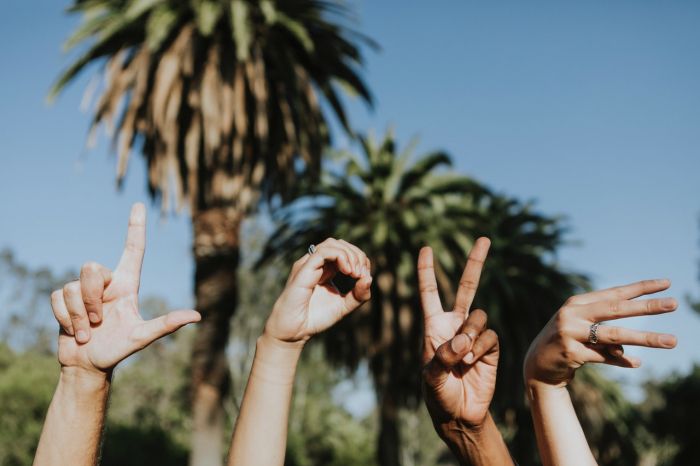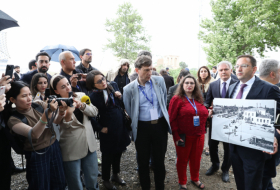Using hand gestures might feel like an intuitive way to communicate across language barriers, but their meaning can change, and there are few universal signs that everyone agrees on.
Our hands are a useful tool for adding meaning to our speech. They might help us to recall words and shape our thoughts – they can even change the sounds our audience hears.
Even people who have been blind from birth gesture as they speak, so you might be led to believe that there is something universally understood about the gestures we make – but that is not the case.
The "thumbs up" might be a common way to show your appreciation on social media, but in some parts of Europe and the Middle East the gesture can be offensive. Just because a gesture is common, it is not necessarily universal, warns Lauren Gawne, a linguist at La Trobe University in Australia.
And its meaning can change over time. News stories from 2003 reported that US troops travelling through Iraq were greeted by Iraqis with their thumbs up. Were the locals offering their support to the foreign forces or being rude? According to the US Defense Language Institute, a body that provides foreign language training for US forces, Middle Easterners had adopted the Western use of the thumbs up after the first Gulf War as a symbol of their support.
Perhaps they weren't being as rude as some thought. More recent diplomatic trips to the Middle East also suggest that the Western use is widespread. But even in the West, a thumbs up does not universally mean the same thing. Scuba divers, for example, use thumbs up to mean "I'm going up to the surface".
The origins of the thumbs up are contentious. Some attribute it to the climax of gladiatorial battles, in which the fate of the losing fighter was decided. Whether a thumbs up or down meant life or death, or whether any thumb at all was a good thing, is disputed. That the gesture of showing someone your thumb has survived longer than the spoken Latin language is mightily impressive, says Gawne. It shows the power of a gesture to cross cultures and time. But, the fact that its origins are mysterious and its use has changed from being an indication of life or death to "everything is OK" or something obscene, demonstrates that hand gestures might not have the same meaning forever.
Like with the Iraqis greeting the Americans, it's possible for a gesture to mean two things at once, or two gestures to mean the same thing. "In parts of the Mediterranean, Turkey, Greece and in southern Italy, you have alternative ways of saying 'no'," says Kensy Cooperrider, a cognitive scientist at the University of Chicago. You could shake your head or you could withdraw your head, pulling it away from the other speaker. "And so you might get both of those gestures in the community at once."
Another example of a meaning that has various gestures is pointing. Nick Enfield, a professor of linguistic anthropology from the University of Sydney, suggests that pointing was a precursor to language itself, essential to early human communication. But pointing is not the same in every culture. In parts of the Americas, Africa, southeast Asia, Australia and Oceania, pointing with the head, nose or lips is common. Cooperrider suggests that those cultures might value discretion when, for example, hunting. It is important to be able to subtly communicate the direction of a target without raising attention.
So, if something as universal as approval, disapproval and pointing can be different across cultures, is there anything that has the same meaning to everyone? And would those gestures stand the test of time?
"People everywhere seem to like to gesture about time, they like to locate tomorrow in one position and yesterday in another position, where exactly they locate them might vary by culture," says Cooperrider. For English speakers, time moves from left to right and we tend to gesture about things in the future in front of our bodies and things in the past over our shoulders, he says.
Both Gawne and Cooperrider say that the "palm-up shrug" appears to be very common, though its origins are not certain. Leonardo da Vinci wrote about and painted the gesture in the 15th Century (three of the attendees in The Last Supper appear to be shrugging). But Cooperrider has also studied modern cultures, from Arabic to Zulu, in which the gesture seems to translate.
Gestures that communicate a specific meaning, like "I don't know" or "everything is OK", are called emblematic gestures. "If you look across cultures, these emblematic gestures are used for interpersonal control," says Cooperrider. "They're not used to describe objects. You might imagine that people will have a gesture for water, meat, for running and so on. But that's not the case. These gestures are primarily about trying to manipulate the social world, to get people to stop doing what they're doing or to respond to questions."
So, while there might be subtle differences, there are some basic meanings that most cultures seem to communicate with their hands and bodies. Cornelia Müller, a professor of linguistics from European University Viadrina Frankfurt, suggests that the basic building blocks of gesture can be broken down further. She describes four types of hand gestures: ones that mould, draw, act and represent.
Moulding involves using the hands to shape an object in front of you. For example, a football referee might use both hands with flat palms to shape a ball (a gesture used to show a defender has made a fair tackle). Drawing is similar, though usually involves the use of fingertips to trace around an object (like a referee tracing a rectangle to represent asking for a video review).
Acting involves miming the action of an object, as though that object were in the mime's hands (like pretending to write with a pen), and representing involves using the hand as a replacement for an object (like using an open palm to represent paper). If you were to mime “asking for the bill” by holding an open palm up and pretending to write on it with the other hand you would be doing both of these last two actions. The open palm is representing a piece of paper, the other hand is acting using the pen.
Many younger readers might never have paid a bill with a signature with the rise of contactless and in-app payments (a trend hastened by the pandemic). But the gesture will still get the desired response, showing that signs can lose their literal meaning but still retain symbolic value.
Simon Harrison, a gesture studies researcher from City University of Hong Kong, suggests that basic categories should be universally understood. People can tell when someone is trying to shape an object in front of them or when they are miming an action, even if what they are trying to communicate is not understood.
With these building blocks of emblematic gestures, new signs can be created. Harrison has studied gestures in industrial environments, like loud food production plants in which workers have to wear face masks. In those environments, a gesture is the most useful way to communicate. Harrison says that people intuitively create and understand simple actions like "stop", "repeat" and "more", and can code their own sign language.
Where gesture becomes more subjective is when we focus only on a hand displaying a symbolic shape like a thumbs up. These are arbitrary symbols of the concepts they represent – there is nothing literal about showing someone your thumb that means everything is going well. Because of their subjectivity, their meaning can come and go, says Gawne.
Like the thumbs up, the mano in fico or "fig sign" has had various meanings, from vulgar to harmless, around the world. The sign is one of about 20 that features in the 1832 book Gesture in Naples and Gesture in Classical Antiquity. In Italy and some other European countries it is equivalent to showing someone a middle finger, though elsewhere, like in Croatia, it represents not having something that another person is looking for (all you have is a fig). To readers in the UK or US it might look much more like a gesture made towards children when an adult pretends to take their nose.
But Harrison says the context should make the meaning clear. While the same hand gesture might have multiple meanings, we piece together the intention of the signer from the context as a whole – what they are saying and how they are acting. Studying drawings of hands from obervations made hundreds of years ago will only reveal a limited understanding of how that gesture was used.
"I would argue that their ways of discussing gesture…is limited for approaching human relationships," he says. "[They] seem so different to the ways bodies, movement, and minds are treated by thinkers."
No hand gesture is ever read in isolation, with the exception of one kind: emoji.
The Internet has opened up this explosion of informal written communication and there's been this gap in what we can express in informal writing – Lauren Gawne
If you have ever struggled to express sarcasm in text you might have resorted to using emoji to help you out. Gawne says that our written language is distinctly lacking in ways to express sentiments like sarcasm because informal writing is a relatively new idea. For millennia, she says, informality was restricted to speech.
"The Internet has opened up this explosion of informal written communication and there's been this gap in what we can express in informal writing," she says, "An emoji is one of the resources people have taken to fill that gap."
Gawne has worked with linguist Gretchen McCulloch and Jennifer Daniel from Unicode to include a greater diversity of hand gestures in the official Unicode dictionary of emoji. What excites Gawne about encoding hand gestures in the Unicode dictionary is that they are so versatile. The fact that (like real hand gestures) their meanings can change is useful, she says. An image of a starfish is a starfish to everyone, but a hand shape can have whatever meaning the users want to ascribe to it.
The earliest hand gesture emoji were a raised fist, a hand with two fingers making a "V" shape and an open raised palm. Initially these represented "rock", "scissors" and "paper", though a "V" shape can also represent "peace" or "victory" and a raised fist "Black Lives Matter".
Gawne is hoping that an emoji of a raised little finger will one day make the cut. This gesture might make English speakers think of "pinky promises" or even sipping tea, but in India it is a useful code for subtly asking for directions to the toilet. The proposal for the raised little finger put forward by Gawne and her colleagues suggests it can mean: fancy, classy, etiquette, promise, effort, toilet and power move.
The subcommittee that approves new proposals takes their time – once a new emoji is included it is there forever. But for researchers like Gawne, that permanent record is useful. "[Before there were digital records or video] we probably lost a whole range of specialist gestural communication, but we have no idea."
Gawne's wait for the raised little finger goes on. Should it make the cut, a culturally-specific (and useful) way to ask for directions to the lavatory will forever be saved in our digital records. Perhaps the meaning of one more gesture would be saved.
BBC
More about:
















































